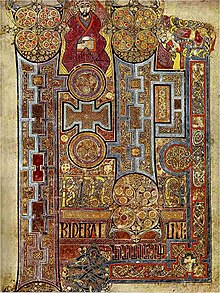
Back أيرلندا الغيلية Arabic Irlanda celta AST Iwerzhon Ouezelek Breton Irlanda celta Catalan Gaelské Irsko Czech Irlanda celta Spanish Irlanda gaelikoa Basque ایرلند گالیک Persian Irlande gaélique French Éire Ghaelach Irish
| History of Ireland |
|---|
 |
|
|

Gaelic Ireland (Irish: Éire Ghaelach) was the Gaelic political and social order, and associated culture, that existed in Ireland from the late prehistoric era until the 17th century. It comprised the whole island before Anglo-Normans conquered parts of Ireland in the 1170s. Thereafter, it comprised that part of the country not under foreign dominion at a given time (i.e. the part beyond The Pale). For most of its history, Gaelic Ireland was a "patchwork"[1] hierarchy of territories ruled by a hierarchy of kings or chiefs, who were chosen or elected through tanistry. Warfare between these territories was common. Traditionally, a powerful ruler was acknowledged as High King of Ireland.[a] Society was made up of clans and, like the rest of Europe, was structured hierarchically according to class. Throughout this period, the economy was mainly pastoral and money was generally not used.[2] A Gaelic Irish style of dress, music, dance, sport and art can be identified, with Irish art later merging with Anglo-Saxon styles to create Insular art.
Gaelic Ireland was initially pagan and had an oral culture maintained by traditional Gaelic storytellers/historians, the seanchaidhthe. Writing, in the form of inscription in the ogham alphabet, began in the protohistoric period, perhaps as early as the 1st century. The conversion to Christianity, beginning in the 5th century, accompanied the introduction of literature. In the Middle Ages, Irish mythology and Brehon law were recorded by Irish monks, albeit partly Christianized. Gaelic Irish monasteries were important centres of learning. Irish missionaries and scholars were influential in western Europe and helped to spread Christianity to much of Britain and parts of mainland Europe.
In the 9th century, Vikings began raiding and founding settlements along Ireland's coasts and waterways, which became its first large towns. Over time, these settlers were assimilated and became the Norse-Gaels. After the Anglo-Norman invasion of 1169–71, large swathes of Ireland came under the control of Norman lords, leading to centuries of conflict with the native Irish. The King of England claimed sovereignty over this territory – the Lordship of Ireland – and the island as a whole. However, the Gaelic system continued in areas outside Anglo-Norman control. The territory under English control gradually shrank to an area known as the Pale and, outside this, many Hiberno-Norman lords adopted Gaelic culture.
In 1542, the Lordship of Ireland became the Kingdom of Ireland when Henry VIII of England was given the title of King of Ireland by the Parliament of Ireland. The English then began to extend their control over the island. By 1607, Ireland was fully under English control, bringing the old Gaelic political and social order to an end.
Cite error: There are <ref group=lower-alpha> tags or {{efn}} templates on this page, but the references will not show without a {{reflist|group=lower-alpha}} template or {{notelist}} template (see the help page).